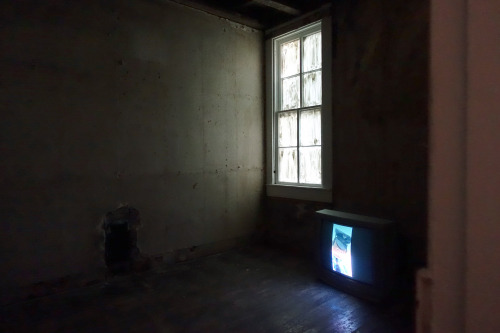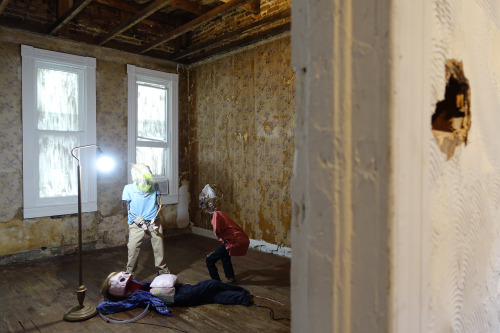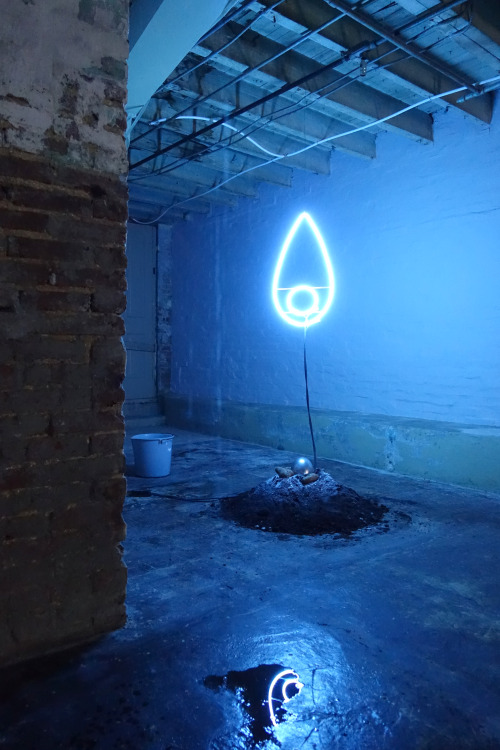It is fitting that Ajay Kurian’s show at Rowhouse Projects uses the word “work” in its title: Work Harder Under Water. The mega exhibition, consisting of three floors (several rooms to a floor) indeed shows a lot of work. The install utilized a multitude of media including the aroma of freshly fried fish prepared by Kurian’s mother, and served, at times by the artist himself throughout the opening. The home cooking and inclusion of family nicely complimented the ever-present domestic atmosphere of Rowhouse Project’s interior on its opening night.
The home cooking was not the only reference to consumption or childhood in the show. Upon entering the foyer of the house, you were greeted by a sculpture of a black frog serving a speaker on a platter garnished with an assortment of faux leaves. Adding to the prankish absurdity, the frog’s pants were pulled down revealing heart patterned boxers. Catching the waiter in this goofy yet humiliating state of undress was erksome and there was a sadness underneath the lightheartedness of this sculpture. The encounter with the humiliated frog waiter as an entry to the show is emblematic of the title of the exhibition, “Work Harder Under Water.” The waiter’s work is undermined by his appearance of ineptitude. The voyeuristic quality of this moment was just a taste of what more was to come further on into the exhibition.
In the same room, a caricature of a high school aged Kurian was silkscreened on the maroon red wall in butter. The cartoonish portrait depicted the artist as a hairy ape with a human face. The greasy substance made the image only faintly visible and suggested certain racial slurs like grease monkey etc. The ape-man caricature is particularly poignant considering the press release for the exhibition, which details the artist’s experiences growing up as a person of color around the time of 9/11. “The membership into a white world that I had so assiduously earned was then called into question,” (speaking of the post 9/11 political climate). “The jokes and playful fears manifested in suggesting I better not grow a beard when I go to New York were meant to show that I wasn’t a terrorist, but that I’m one facial hair mishap away from fitting the description,” reads the press release.

Continuing through the house, you came to a beer-pong sized folding table supporting a ten gallon Igloo water cooler in bright orange (a humorous decoy to the beverages typically provided at openings).
Within the belly of the cooler was a silver ironman looking mask submerged in a lemon-lime colored liquid. The way the mask glimmered under water (another tie in to the title of the show) resembled shiny change in a fountain, tossed in for good luck. The liquid softened the exaggerated masculine features of the mask making it appear more as an illusion of masculinity rather than a symbol of it.
Just past this room, Kurian’s mother fried the fish in the house’s kitchen. The staging of this scene reads like a snapshot made to be viewed in real time. To quote Gaston Bachelard in The Poetics of Space, “We realize that the calendars of our lives can only be established in its imagery.” Through this scene, the theatre of memory is revisited and the physiological reverberations of the act are absorbed in the walls of the house along with the aroma.

Positioned there on a wooden shelf was a derelict sculpture presenting a much less edible food; two Styrofoam containers from Cup Noodles were placed several inches apart. In one of the containers was body hair from Kurian soaked in about two inches of Neem oil. The adjacent soup container held the recently extracted molars from the painter Jamian Julliano-Villani, also soaked oil. These abject cast offs can signify our mortality while also provoking disgust at the fate of our ultimate decay and the messiness that goes along with it. The primal body is treated in pieces and sorted as a doctor might while performing an autopsy. In this tableau, the fragility of the body is gently contrasted with the stark materiality of the synthetic soup containers.
The oil has Old Testament significance as well. Oil as a magical material, one that can mysteriously extend its own life, etc., offers a trace of hope.
Up the stairs and to the right is a large room in which three child-sized figures engage in a homoerotic display of pre-prepubescent debauchery. One of the boys (he had a clear piece of vinyl tubing in place of a phallus indicating that he was male) was urinating into the mouth of another figure positioned directly beneath the first while another one of the figures watched in giddy anticipation. Or was it horror? These figures looked like skeletons from hell dressed in Old Navy mimicking a frat house hazing session. Physically the “boys” were in different stages of decomposition or deconstruction. Parts of their armatures were left exposed. Their wigs hastily positioned atop uneven skulls. The voyeur of the group, the child who was not peeing or being peed on, had black skin while the other two characters skin could be described as white. I am having a hard time deciphering what the significance is for the black kid to bear witness to the sadomasochistic performance of the white children but to say that it was a hellish scene and the figures all appeared to be demons in it.
The fluids from this perverse vignette trickle down the house, unseen, literally soaking the foundation of the institution in the depravity. The “urine” eventually reaches the intimate space of the basement where it is caught in strategically placed cookware (pots and bowls). The basement or cellar of a house signifies the irrational. According to Bachelard who wrote; “In the cellar, “rationalization” is less rapid and less clear; also it is never definitive.” If the structure of the house mimics the human psyche the subterranean space of the basement, inherently dark and damp, is where secrets are kept. “The cellar dreamer,” states Bachelard, “knows that the walls of the cellar are buried walls, that they are walls with a single casing, walls that have the entire earth behind them. And so the situation grows more dramatic, and fear becomes exaggerated.” It is where one might give in to temptations, or regress to the primitive.
Perhaps this is why, in this same space Kurian hung electric neon light in the shape of the neighborhood watcheye pointing out the relationship between light and vision. But in this case vision is also a stand in for power. The neighborhood watcheye, a symbol for vigilantes, disrupts the nature of the cellar. The cellar cannot be a space to stowaway childhood fears because it is under surveillance. “But the unconscious mind cannot be civilized,” Bachelard writes.
Back upstairs, themes of race, power and consumption are subtly carried through in a video of a black police officer puppet attempting to eat his arm. Using the body and a nonsensical gesture, the piece looks like Sesame Street appropriating Vito Acconci’s early video work.

The show utilized every corner of the space with objects both deeply rooted in personal narrative and universal concepts; race, coming of age, consumption, violence. Children’s toys were used in several sculptures tracing the subtle significance of those objects on the psyche of the adult they help to shape. An oversized Jacob’s Ladder hanging in the stairwell of the house was particularly metaphorical. Climbing a Jacob’s Ladder does nothing to bring you forward while climbing the stairs in the house is what one must do to see the piece. The Jacobs Ladder, like a stationary bike, contradicts itself. It is the children’s equivalent to the myth of Sisyphus summed up in one elegant object.
The installation also made exciting correlations to Bachelard’s theory that the structure of the house parodies the human psyche. The functions of rooms of the house correlated poetically to the sculptures they harbored. In several pieces the artist used water or, “being under water” as the title phrases it to symbolize how one might struggle with the themes presented in this show. Like trying to run in a dream, working harder under water is futile and all efforts at it are ultimately doomed to fail.
Work Harder Under Water is on view by appointment only from September 26, 2015 through November 14, 2015. All images courtesy of Rowhouse Project.